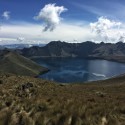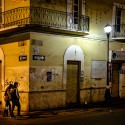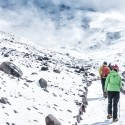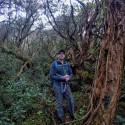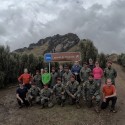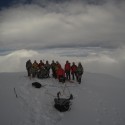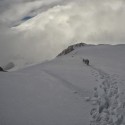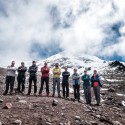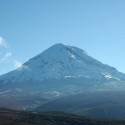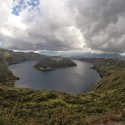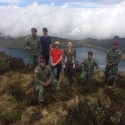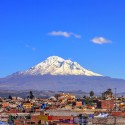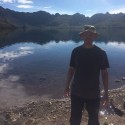Julian Assange, quinoa, the equator and volcanoes seemed to top the ‘pub quiz’ answers connected to Ecuador. So when the question: ‘Do you want to go on an expedition to Ecuador?’ was asked the obvious answer to me was ‘Yes’.
As a trained geography teacher who’d never quite managed to cross into the southern hemisphere the lure of the equator was great. Also, the expedition was planned for January when the weather in the UK was guaranteed to be cold, dark and miserable. I’d read enough Joseph Conrad and Jules Verne to know that the equator would be delightfully warm. The lure of some actual, real volcanoes rather than YouTube videos narrated by Professor Iain Stewart was also a draw. I’m a big fan of quinoa as well though I hoped the local cuisine wouldn’t rely too heavily on this Andean superfood.
Everyone’s aims for the expedition were slightly different. Some people would be totting up log book experience, others revisiting old haunts and for some it might be a life changing experience in a new culture. My aims were threefold: firstly to have an enjoyable and rewarding cultural experience, next to push myself on the physical and technical aspects of ‘alpine’ mountaineering and lastly to peak on some very high mountains.
Aim 1. Ecuador did not disappoint. It is a stunning country with friendly people, a varied and interesting cuisine including just enough quinoa and beautiful scenery. A real bonus which added hugely to the trip was our engagement with a group of Ecuadorian Special Forces. No matter what level of language skills we shared these guys were a real boon to the trip. On the steepest climbs they showed us the way forward (as they tended to be at the front) and we also gained a ton of cultural knowledge. A highlight for me was watching Capt Smith’s face when he came into the room to see me playing Ecuadorian Rummy for cash with three of the toughest guys in Ecuador.
The balance of the trip between mountaineering and acclimatisation (work and play) was pretty much perfect. Free days in Otavalo and Quito allowed for rest, a little shopping and a chance to practice some rope work. Free days also allowed us to scope out restaurants for the evening meal. Good food proved quite easy to source though good tea and coffee were a little harder to find.
Aim 2. One of the joys of acclimatisation is that altitude is built up gradually. Our first days in the mountains involved gradually longer and higher trips with very different attributes. Our first walk was around the rim of Cuicocha crater- an enjoyable family stroll. Next was a Dartmoor style slog around a damp Laguna Grande De Mojanda finishing up with a British style drenching. Cerro Negro introduced us to paramo grasslands and 45 degree slopes. This was a tough combination as we followed camouflaged Ecuadorians up to 4212 metres. Fuya Fuya was a similar challenge, 40 metres higher and with the most stunning views so far.
Though we hadn’t had to use ropes, crampons, axes, etc. in anger yet, we had had the opportunity to train with them. In Quito this involved practicing rope work in the hotel car park. This drew some strange looks especially as we were wearing winter gloves in 25 degree heat. A mountain shelter and track provided the perfect places to practice self-rescue and team crevasse rescue. Whether these were new skills or skills to be practiced I think every member of the team benefited from these sessions.
A lot of the rope skills were finally used on the ascent of Imbabura, a 4630 metre peak with 1300 metre height gain and a long, rocky ridge marking part of the former volcanoes rim. Though Imbabura was just short of the snow line (it had a dusting) we used Alpine tactics to keep safe. Alpine mountaineering involves being roped together in small teams so slips, trips and falls can be arrested before they become serious. It also involves walking very quickly so as to limit exposure to rock fall, inclement weather and being behind anyone else. This day was a good example of how tough experiences can be amongst the most rewarding.
Aim 3. If my glass was half empty, aim 3 might be regarded as a bit of a failure. Despite all the training, practice, acclimatisation and planning we didn’t manage to get to the top of either Cayambe or Chimborazo. In fact, on both mountains we got to about 5700 metres; which is a great success. 5700 metres is almost twice as high as I’d ever been before. Conditions are tough: it is cold, the air is thin, walking is hard and potential dangers are everywhere. On Cayambe we were turned around by deep snow delaying us by so much that melting snow bridges over crevasses was going to pose a real threat. Chimborazo had perfect weather conditions but an avalanche threat on the glacier which meant heading back down was the only option.
Also, by not completing aim 3 it means aim 4 comes into existence: return to Ecuador, enjoy the culture again, use some of the skills learnt on this trip and have another crack at Cayambe and Chimborazo.
By LCpl Longyear, 135 Geo Sqn RE

